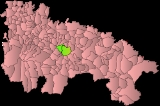
Viguera
Encyclopedia
Viguera is a municipality in La Rioja, Spain
. It includes the villages Castañares de las Cuevas, El Puente, and Panzares.
recovered La Rioja in 759, after it having been conquered by Alfonso I of Asturias
in 755. He commented in particular that after taking Viguera Castle, Abd ar-Rahman I crossed all of La Rioja and penetrated Álava
.
It was one of the fortifications that the Banu Qasi
used to defend La Rioja from the Christians.
In the second half of the ninth century, Lubb ibn Musa, one of the sons of Musa ibn Musa ibn Qasi
, reconstructed the fortress. Lubb died hunting deer and was buried in the location.
Upon Christian reconquest
, it became the site of the Kingdom of Viguera
(970-1005). At the end of this period, it became part of the Kingdom of Navarre
, although later the area passed into the hand of the nobles of Cameros, as part of their feudal territory.
Demographic evolution of Viguera during the twentieth century
.jpg)
Spain
Spain , officially the Kingdom of Spain languages]] under the European Charter for Regional or Minority Languages. In each of these, Spain's official name is as follows:;;;;;;), is a country and member state of the European Union located in southwestern Europe on the Iberian Peninsula...
. It includes the villages Castañares de las Cuevas, El Puente, and Panzares.
History
The earliest documentary evidence is in the Berber historian Ajbar Machmua, who told that Abd ar-Rahman IAbd ar-Rahman I
Abd al-Rahman I, or, his full name by patronymic record, Abd al-Rahman ibn Mu'awiya ibn Hisham ibn Abd al-Malik ibn Marwan was the founder of the Umayyad Emirate of Córdoba , a Muslim dynasty that ruled the greater part of Iberia for nearly three centuries...
recovered La Rioja in 759, after it having been conquered by Alfonso I of Asturias
Alfonso I of Asturias
Alfonso I , called the Catholic , was the King of Asturias from 739 to his death in 757.He was son of Duke Peter of Cantabria and held many lands in that region. He may have been the hereditary chief of the Basques, but this is uncertain...
in 755. He commented in particular that after taking Viguera Castle, Abd ar-Rahman I crossed all of La Rioja and penetrated Álava
Álava
Álava is a province of Spain and a historical territory of the Basque Country, heir of the ancient Lord of Álava. Its capital city is Vitoria-Gasteiz which is also the capital of the autonomous community...
.
It was one of the fortifications that the Banu Qasi
Banu Qasi
The Banu Qasi, Banu Kasi, Beni Casi or Banu Musa were a Basque Muladi dynasty that ruled the upper Ebro valley in the 9th century, before being displaced in the first quarter of the 10th century.-Dynastic beginnings:...
used to defend La Rioja from the Christians.
In the second half of the ninth century, Lubb ibn Musa, one of the sons of Musa ibn Musa ibn Qasi
Musa ibn Musa ibn Qasi
Musa ibn Musa al-Qasawi was leader of the muwallad Banu Qasi clan and ruler of a semi-autonomous principality in the upper Ebro valley in northern Iberia in the 9th century.-Rise:...
, reconstructed the fortress. Lubb died hunting deer and was buried in the location.
Upon Christian reconquest
Reconquista
The Reconquista was a period of almost 800 years in the Middle Ages during which several Christian kingdoms succeeded in retaking the Muslim-controlled areas of the Iberian Peninsula broadly known as Al-Andalus...
, it became the site of the Kingdom of Viguera
Kingdom of Viguera
The Kingdom of Viguera was a short-lived pocket kingdom around the Navarrese town of Viguera from 970 to 1005. It is said to have been created by the testament of García Sánchez I of Pamplona for his second son, Ramiro Garcés, and comprised the region today called La Rioja...
(970-1005). At the end of this period, it became part of the Kingdom of Navarre
Kingdom of Navarre
The Kingdom of Navarre , originally the Kingdom of Pamplona, was a European kingdom which occupied lands on either side of the Pyrenees alongside the Atlantic Ocean....
, although later the area passed into the hand of the nobles of Cameros, as part of their feudal territory.
Demographic evolution
Demographic evolution of Viguera during the twentieth century
Places of interest
.jpg)
- Parish Church of La Asunción: Constructed in the 16th century of masonry and ashlar, recently restored
- Hermitage of Nuestra Señora del Rosario: Based on an earlier hermitage from the 16th century, reformed in the 18th century
- Hermitage of San Marcos: Originally in the 17th century, recently restored by a group of women of the town who, without interest in the devotion of this hermitage or its festival, have restored it
- Hermitage of San Esteban
- Hermitage of Santa Lucía, in the village of Panzares, rebuilt in 1968 above a 16th-century edifice
- Parish Church of La Asunción: In Castañares de las Cuevas, from the 16th century
- Medieval bridges:
- Leaving Logroño near the border of Viguera, 11th century
- After Islallan
Local festivals
- In honor of Saint Mark, April 25
- Patrol festivals in honor of Saint James and Saint Ann. July 25 and 26

